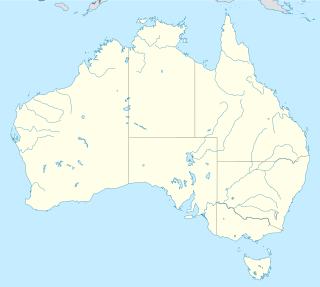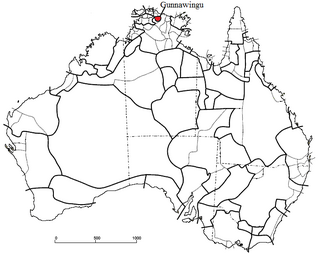Ngalakan (Ngalakgan) is an Australian Aboriginal language of the Ngalakgan people. It has not been fully acquired by children since the 1930s. It is one of the Northern Non-Pama–Nyungan languages formerly spoken in the Roper river region of the Northern Territory. It is most closely related to Rembarrnga.

The Iwaidjan or Yiwaidjan languages are a small family of non-Pama–Nyungan Australian Aboriginal languages spoken in the Cobourg Peninsula region of Western Arnhem Land.
Kunwinjku, also known by the cover term Bininj Gunwok or Mayali, is an Australian Aboriginal language in northern Australia. The Bininj Gun-Wok peoples live primarily in western Arnhem Land. There are perhaps two thousand fluent speakers in an area roughly bounded by Kakadu National Park to the west, the Arafura Sea to the north, the Blyth River to the east, and the Katherine region to the south.
Nunggubuyu or Wubuy is an Australian Aboriginal language, the traditional language of the Nunggubuyu people. It is the primary traditional language spoken in the community of Numbulwar in the Northern Territory. The language is classified as severely endangered by UNESCO, with only 272 speakers according to the 2016 census. Most children in Numbulwar can understand Nunggubuyu when spoken to, but cannot speak it themselves, having to reply in Kriol. To counter this, starting in 1990, the community has been embarking on a revitalisation programme for the language by bringing in elders to teach it to children at the local school.

Dalabon is a Gunwinyguan language of Arnhem Land, Australia. It is a severely endangered language, with perhaps as few as three fluent speakers remaining as of 2018. Dalabon is also known as Dangbon, Ngalkbun, and Buwan.
Gurr-goni, also spelled Guragone, Gorogone, Gun-Guragone, Gunagoragone, Gungorogone, Gurrogone, Gutjertabia, is an Australian Aboriginal language spoken in Arnhem Land. There were about 60 speakers in 2011, all trilingual in Burarra or Gunwinggu.

The Darling language, or Paakantyi (Baagandji), is a nearly extinct Australian Aboriginal language spoken along the Darling River in New South Wales from present-day Bourke to Wentworth and including much of the back country around the Paroo River and Broken Hill. The people's and language name refers to the Paaka with the suffix -ntyi meaning 'belonging to',
Ndjébbana, also known as Djeebbana, Kunibidji, Gunavidji, Gunivugi, or Gombudj, is a Burarran language spoken by the Kunibidji people of North-central Arnhem Land, Australia.

The Gunwinggu people are a tribe of Australian Aboriginal people, forming part of the Bininj Gun-Wok peoples, who live to the east of Darwin, Northern Territory.
Burarra is an Australian Aboriginal language spoken by the Burarra people of Arnhem Land. It has several dialects.
Maung is an Australian aboriginal language spoken by the Maung people on the Goulburn Islands, off the north coast of Arnhem Land, in the Northern Territory of Australia. Maung is closely related to Iwaidja language which occupies the northwestern corner of the opposite mainland. This is a language that belongs to the Iwaidjan language family of Non-Pama–Nyungan languages. As of 1983, there were 200 speakers of the language.(Ethnologue)
Gunbarlang (Kunbarlang) is an Australian Aboriginal language in northern Australia with multiple dialects. Other names are Gungalang and Warlang. Speakers are multilingual in Gunwinygu and Mawng. Most of the Gunbarlang people now speak Gunwinygu.

The Macro-Gunwinyguan languages, also called Arnhem or Gunwinyguan, are a family of Australian Aboriginal languages spoken across eastern Arnhem Land in northern Australia. Their relationship has been demonstrated through shared morphology in their verbal inflections.
The Giimbiyu were an indigenous Australian people of the Northern Territory. Their descendants having adopted the Kunwinjku language.
The Bininj Gunwok, alternatively Bininj Kunwok, a recent term referring to speakers of a dialect cluster of several mutually intelligible languages, are an indigenous Australian people of Western Arnhem land in the Northern Territory. In 2015 a spelling change was agreed to standardise the spelling across all Bininj Kunwok languages, using the 'k' instead of 'g' form, though older documents still use the 'g' form.
The Warndarang (waɳʈaraŋ) were a predominantly coastal indigenous Australian people of eastern Northern Territory. Though extinct as a distinct ethnolinguistic group, their descendants survive among the neighbouring Nunggubuyu
The Rembarrnga, otherwise known as the Rembarunga, are an indigenous Australian people of the Northern Territory.
The Dalabon or Dangbon are an indigenous Australian people of the Northern Territory.
The Gungorogone are an indigenous Australian people of the Northern Territory.





